WORK WITH LAUREN
The thing about behaviour is that it never switches off.
It hums beneath strategy decks, change plans, and roadmaps.
You see it in the clicks people make, or don’t.
In the trust they give, or hold back.
Most of the time, no one calls it out.
Teams talk about features.
Leaders talk about outputs.
Consultants talk about culture.
Meanwhile, behaviour is the quiet current running through it all.
Sometimes holding things together.
Sometimes pulling them apart.
Who I work with
I work with the teams who know behaviour is the missing piece.
AI and digital adoption teams
Where the challenge isn’t the tech itself but getting people to use it, and keep using it.
Marketing and brand teams
Make sure customer behaviour matches the promise the brand makes. And see which new customer habits to make your own.
Change and transformation teams
Moving from strategy decks to lived reality, with behaviour change at the centre.
Learning & Development
Build behavioural literacy across the organisation. Build a behavioural design curriculum or programme.
Product teams
Scope features that make the most of user behaviour, and make sure they get used.
Service and UX teams
Form and support behaviour change across all touchpoints.
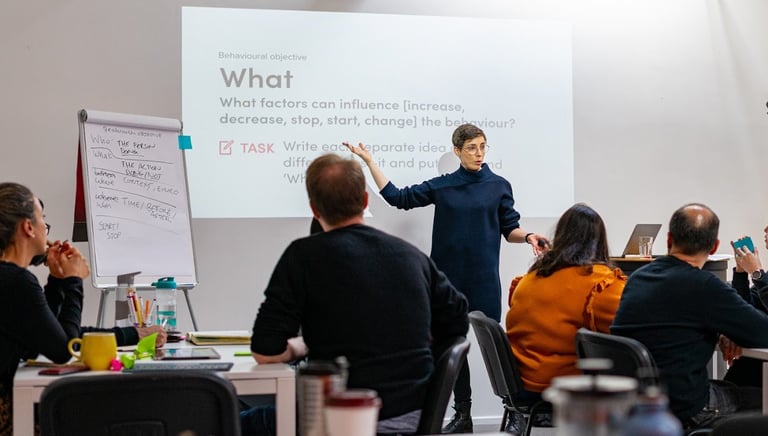

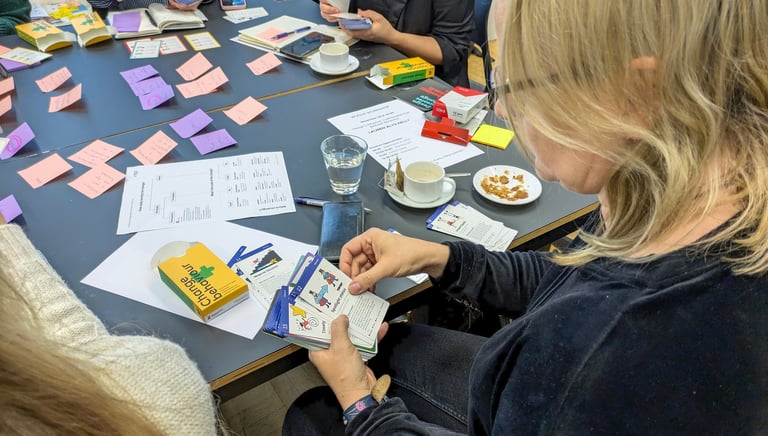

When to bring me in
The best time to bring me in is earlier. When behaviour is part of the converstion from the start, change settles in more easily and lasts longer. The next best time is now.
A change on the horizon
A transformation is on its way. Behaviour is part of the design from the very beginning, not something added on at the end.
Strategy turning into action
The ambition is clear. Now it’s about finding the everyday behaviours that will carry it forward.
A product in development
A tool, service, or AI system is being designed, and adoption matters. Getting trust and flow right the first time feels essential.
Services taking shape
Journeys are being mapped. Touchpoints redesigned. The behavioural layer makes sure the whole system works in practice.
Culture under construction
New values, new ways of working, new norms are being set. Defaults and quiet guardrails can help them hold.
Behaviour as the product
You’re building something behaviour-first.
A culture change. A new system. An AI tool.
And you know getting the behaviour right from day one is what makes or breaks it.
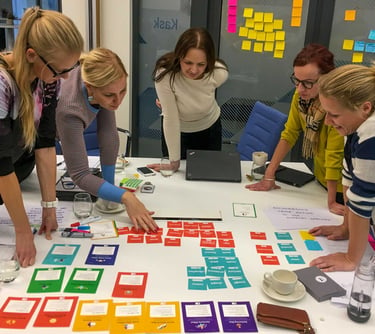

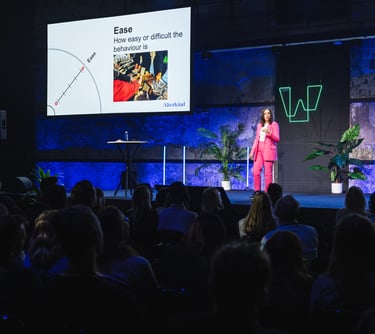

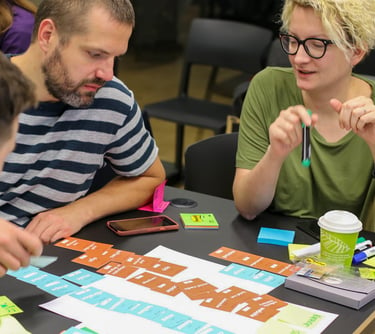

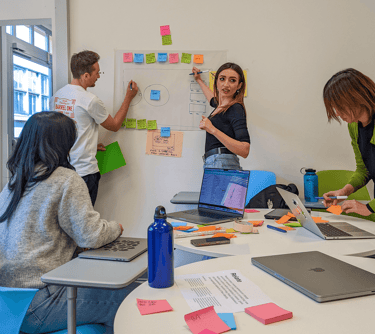

Ways to work with me
Advisory
An ongoing partnership where I sit as your behaviour lead. Regular sessions, quick reviews, and clear calls on where to focus. Keeps behaviour visible in every decision.
Typical: 3–6 months.
Projects
A focused build or re-build. Together we'll design the flows, pathways, and systems that make behaviours start and hold. Diagnosis, testing, and playbooks included.
Typical: 4 day Behaviour Sprint or longer engagement.


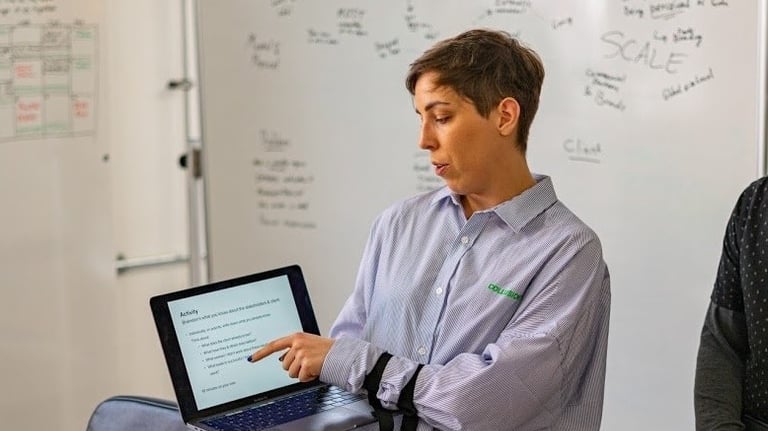

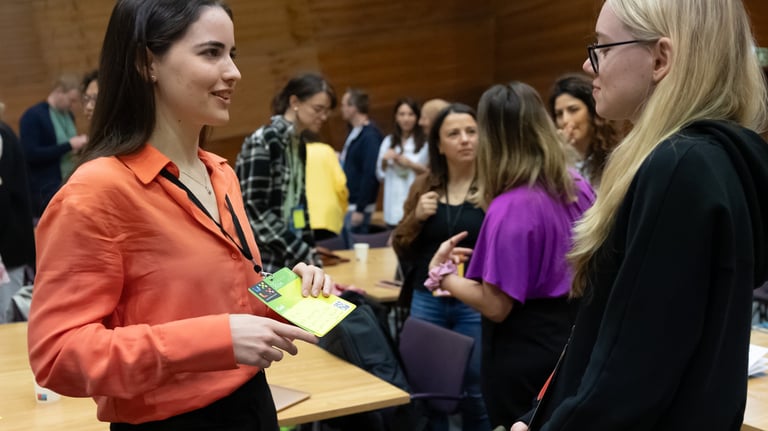

Capability
Coaching or workshops that grow behaviour-first skills in your team. Real work as the curriculum, plain-English tools, repeatable practices.
Typical: Workshops, bootcamps, programmes.
Advisory
Senior eyes on the work
Advisory is the most senior way to bring me in.
It’s like having a behavioural lead at your table. Someone who joins your rhythm, sees the bigger picture, and keeps behaviour visible as the work moves forward.
When behaviour is on the table from the start, fewer things slip through the cracks.
It costs less to fix, and more of your effort pays off. Advisory keeps behaviour in sight.
What it looks like
Regular sessions (usually every couple of weeks) shaped around your live roadmap, flows, or change plans
Clear notes and recommendations within two days, so decisions are easier and risks are caught early
Quick reviews in-between when urgent checks are needed
Light-touch tools: briefs, friction checks, and yes/no calls to keep everyone aligned
Who it’s for
Leadership teams who want senior behavioural experience and judgement without the cost of a full-time hire
Product and service teams who need adoption and behaviour change designed in from the start
Change leaders running transformations who need behaviour goals met
"Genuinely blew us away. Full of ‘why didn’t we think of that?’ moments."
Katie Milioni, CEO of MyHabeats
Projects
Rolling up the sleeves
Projects are where the real building happens.
Sometimes it’s a product that needs designing.
Sometimes it’s a service that needs rethinking.
Sometimes it’s a whole transformation that needs a behavioural spine.
This is the work of making behaviour tangible. With strategies you can follow, designs people adopt, systems that make change last.
What it looks like
Pinpointing the moments that matter. Where trust breaks, adoption stalls, or drop-offs creep in
Roadmaps and priorities that give leaders clarity
Flows and pathways designed with behaviour at their core
Experiments tested in practice
Playbooks and standards your team can keep using long after I’ve stepped back
Ways I work
Behaviour Sprint (4 days): short, sharp, designed to unblock stuck products or programmes
Ad-hoc projects (2-12 weeks): focused engagements that diagnose, design, test, and embed
Behaviour Architecture programmes: deeper work for high-stakes launches, building the full system
“Lauren cut through the noise and gave us actions we could use straight away.”
Arvind Satyam, Chief Commercial Officer, Pano AI
Who it’s for
Product and UX teams where behaviour is make-or-break
Change leaders who need strategy to show up in practice
Service and operations teams who want cleaner flows with behaviour change baked in
Leaders who want a behavioural roadmap
Capability
Growing behavioural literacy
Sometimes the smartest move isn’t fixing the thing.
It’s equipping the people.
Capability work is about giving teams and individuals the skills to use Behaviour Thinking® again and again, long after I’ve gone.
There are two ways: coaching and training.
Coaching
Personal and focused
1:1 or small group sessions for people who want to go deeper.
Often that means behavioural designers levelling up into more senior roles, or professionals who want to sharpen their or their team's behavioural literacy.
Focused sessions on your live challenges, your real work becomes the curriculum
Plain-English and Miro / Pdf frameworks you can apply straight away
A clear path from “I know the theory” to “I can lead this in practice”
Usually booked in blocks of 4 sessions over 8 weeks
“I left every session more confident and clear. Don't think twice about signing up”
Karolina Rucinska, Cynnal Cymru Sustain Wales, Sustainability Strategist
Training
Practical and shared learning
Workshops and bootcamps that build collective skills. Hands-on, rooted in your real work, designed to leave you with tools you’ll keep using.
Half-day or full-day workshops for targeted skills (framing problems behaviour first, spotting friction, designing defaults). Ask me about my current workshops.
Multi-day bootcamps for deeper capability building
Templates, playbooks, and a shared language the whole team can use
Optional “train-the-trainer” programmes so skills spread further
Delivered online or in person. In person easily delivered with UK and European companies. Always tailored to your goals.
“The team are now all putting the user first, something we’ve found difficult to instil across all departments.
Vanja Lagercrantz, Head of User Experience and Design, Coop Sverige
“Some of the best training we have had, no small feat given the remote nature of it."
Fjord
Work highlights
Corporate & Enterprise
Meta • PwC • Accenture • Infosys Consulting • A1 • Microsoft
Public Sector & NGOs
World Economic Forum • DWP • British Government's Equalities Office • Estonian Government's Innovation Office • ISeeChange
Design, Innovation & Change Agencies
Mima • Coop Digital • Coop Sweden
Educational Institutions
Hyper Island (Behavioural Design course creator and lecturer) • Politechnico di Milano (faculty member for Behavioural Design) • Manchester Met University (20 hour course creator work 60 credits) • Estonian Academy of Arts (Licensed BehaviourKit for use, up-skilled the faculty) • D&AD
Speaking
UXLX, PwC Change Conference (twice), WUD, Estonia (twice), Whext, SEMPL, BrandFestival, Golden Drum, Service Design Network, People of Research
Clients
How I work
The work shifts depending on what’s needed.
Sometimes I’m a Designer. Sometimes a Strategist.
Sometimes a Scientist. Sometimes an Architect.
Each lens sees something different. Together, they make the picture whole.
1. Behavioural Designer
I take the ideas of behavioural science and turn them into things people can actually use.
Sometimes that’s a product journey that nudges a choice in the right direction.
Sometimes it’s a service touchpoint that takes the edge off at just the right moment.
If you’ve heard of ‘behavioural interventions’, that’s what this is.
I work shoulder to shoulder with product teams, marketers, and designers,
translating research into real experiences that land in people’s hands.
2. Behavioural Strategist
Here the view widens.
I help organisations define the change they’re really chasing. Translating goals into clear, measurable behaviours.
I look for hidden barriers, the small frictions that block progress.
Then I map the way forward: where to focus, what to measure, how to keep momentum.
3. Applied Behavioural Scientist
Sometimes the work is technical.
Trials. Nudges. Measuring shifts.
Designing experiments to see what holds in the real world, and what falls away.
I work with analysts, researchers, even government teams.
It’s careful, rigorous, and it gives leaders confidence to act.
4. Behaviour Architect
This is the systems view.
Not just one journey, but the whole architecture holding behaviour in place.
I look at flows, defaults, ownership.
At how trust is built in.
At how governance, playbooks, and design systems can support the right behaviours
quietly, consistently, long after the project ends.
It’s about weaving behaviour into the fabric of an organisation and product so it doesn’t rely on one-off campaigns or lone champions. If you’ve heard me recommend creating Behaviour Owners as a role, this is where that belongs.
Contact
If you’ve read this far, you already know behaviour matters.
I’d love to help you get it right.
Contact direct at
lauren@laurenkelly.me or use the form
© 2025, Alterkind Ltd. All rights reserved.